As an Amazon Associate I earn from qualifying purchases.
If you want to make the best venison burgers, you’ve come to the right place. I’ve worked at gourmet burger joints, made thousands of burgers and have perfected this particular venison burger recipe over the past 20 years. It’s the real deal, and it’s a lot easier than you think to make a memorable deer burger.
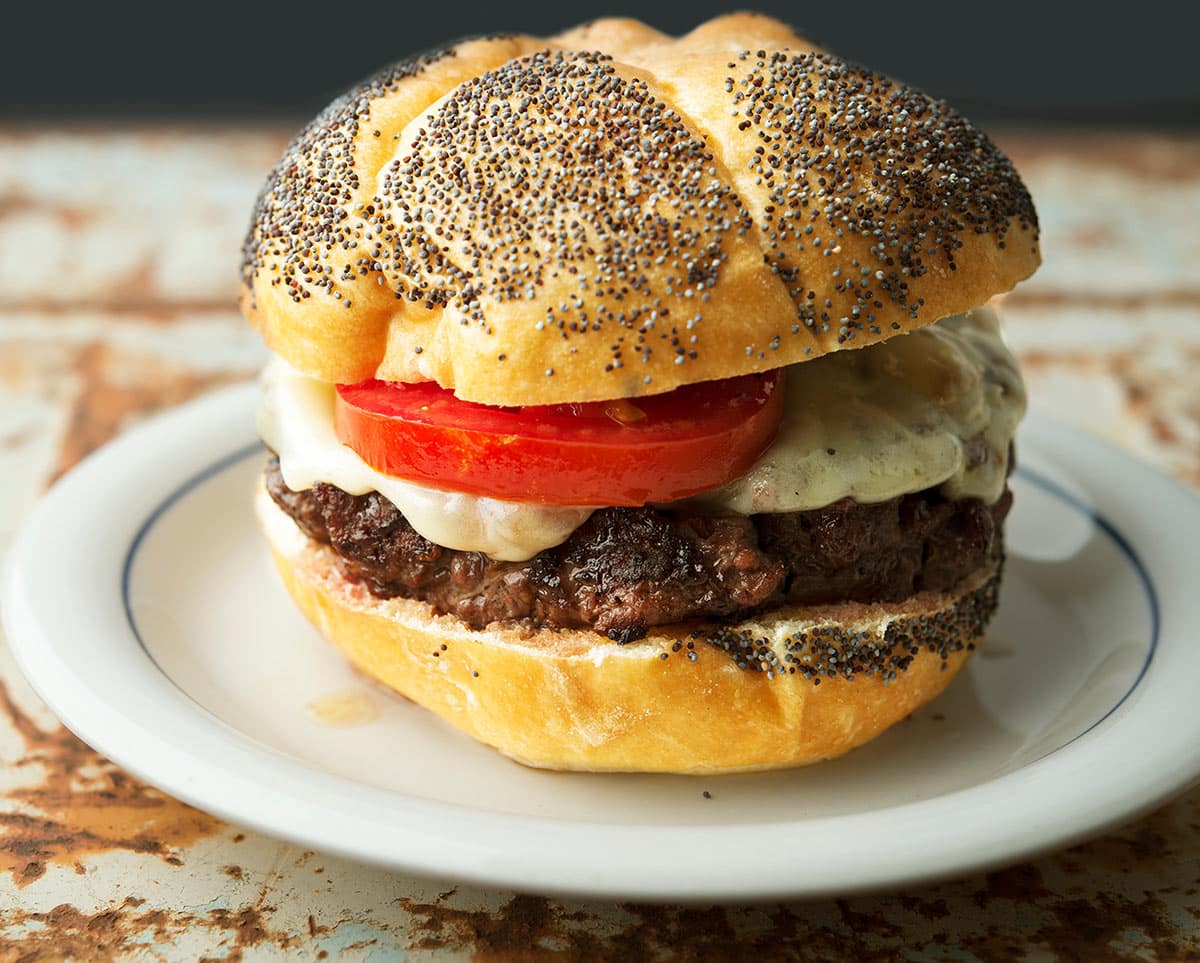
Ideas about the “perfect burger recipe” are as varied as there are minds to contemplate such weighty matters. I’ve thought a lot about what makes “perfect” venison burgers over the years, so here goes. Let’s start with some basics.
For starters, a great many “perfect deer burger” recipes are not actually burgers: They’re sausage patties, technically speaking. For a burger to be a burger, it is nothing more than meat and fat and maybe salt. No Saltines, no Lawry’s spice in the mix, no breadcrumbs or anything like that. All those things might taste nice, but they are not really a burger.
For a burger to be a real, honest burger, it should be a celebration of the meat it is made of. In this case deer burger — or elk, moose, antelope, caribou, whatever. I use “deer meat” in the abstract, not the specific. More in a bit.
Fat in Venison Burgers
Ideally, a great burger has ample fat, somewhere between 10 and 20 percent by weight. I am partial to 15 percent. In the case of venison burgers, only a little of that fat is from the deer because too much deer fat will ruin the mouthfeel of your venison burgers. (More on the ins and outs of cooking with deer fat here.)
When I make my own burger grind, I will add about 5 percent deer fat, just for flavor. This is not enough to get that waxy nastiness, but is enough so you know you are eating venison burgers, not ones made from beef. Most of this 5 percent comes from bits of fat on the pieces of meat I am grinding; I rarely add it specifically. If for some reason you happen to have bison on hand, grind it with its own fat — it will be amazing.
Beef fat trimmed from steaks and roasts, or pork fat are what I recommend for the rest. I’ve also used bacon ends; they’re sold in large vac sealed bags in most supermarkets.
Beef fat trim is better for burgers but harder to find, and it will skew the flavor of your venison burgers towards a “regular” burger, while pork fat is easier to get and more neutral, but is a little softer. I’ve seen lamb fat in venison burgers, too, and it’s OK, but a little too hard for me.
Do not add already rendered fats, such as lard, to the mixture. Pre-rendered fat will simply melt and leak out and stay in your pan, or cause flare-ups on your grill. You need actual pork or beef fat.
Meat in Venison Burgers
Duh, venison. But from where? I’ve seen complicated equations involving exact percentages of this cut of meat or that one, including such horrors as including hanger steak or skirt steak in a burger. These are noble cuts, not something to be ground into venison burgers. Might as well grind a ribeye. And yes, I am certain at least one person reading this has done that.
I generally do two different grinds for different sorts of venison burgers: A coarse and a fine grind. The coarse grind, 6 mm in the meat grinder if you want specifics, I make with clean fat and stew meat. I rarely grind this twice. The fine grind I use random trim with fat, and I always grind that twice, first coarse and then through a 4.5 mm die. Generally speaking, the gnarlier the meat is, the more and finer it should be ground. But basically any cut on the animal works.
And if you are worried about “gamey meat,” read this article. It should answer all your questions.
Pre-ground Venison
This one’s for those of you who don’t butcher your own animals. You’ll be given one-pound packets of ground venison from your butcher or processor. (Often it’s not your deer, but that’s another story.) Now you should always have the option of having fat mixed into the grind. I’ve never heard of a processor who didn’t offer that. Take them up on that offer if you want to make venison burgers. Again, beef or pork, it’s up to you.
For those of you who don’t want fat in your venison burgers, know that they will be dry and awful unless you decide you don’t want an actual burger. Most people in this case add those Saltines or breadcrumbs or eggs, and all of these additions make it a sausage patty, not a burger. Some of those taste fine. But if you are in the no-fat crowd, this is not the venison burgers recipe for you.
A final note on pre-ground venison: It’s rarely ground twice, and it is usually somewhere between coarse and fine. In my mind, the worst of both worlds, but hey, it’s better than not having ground venison, right?
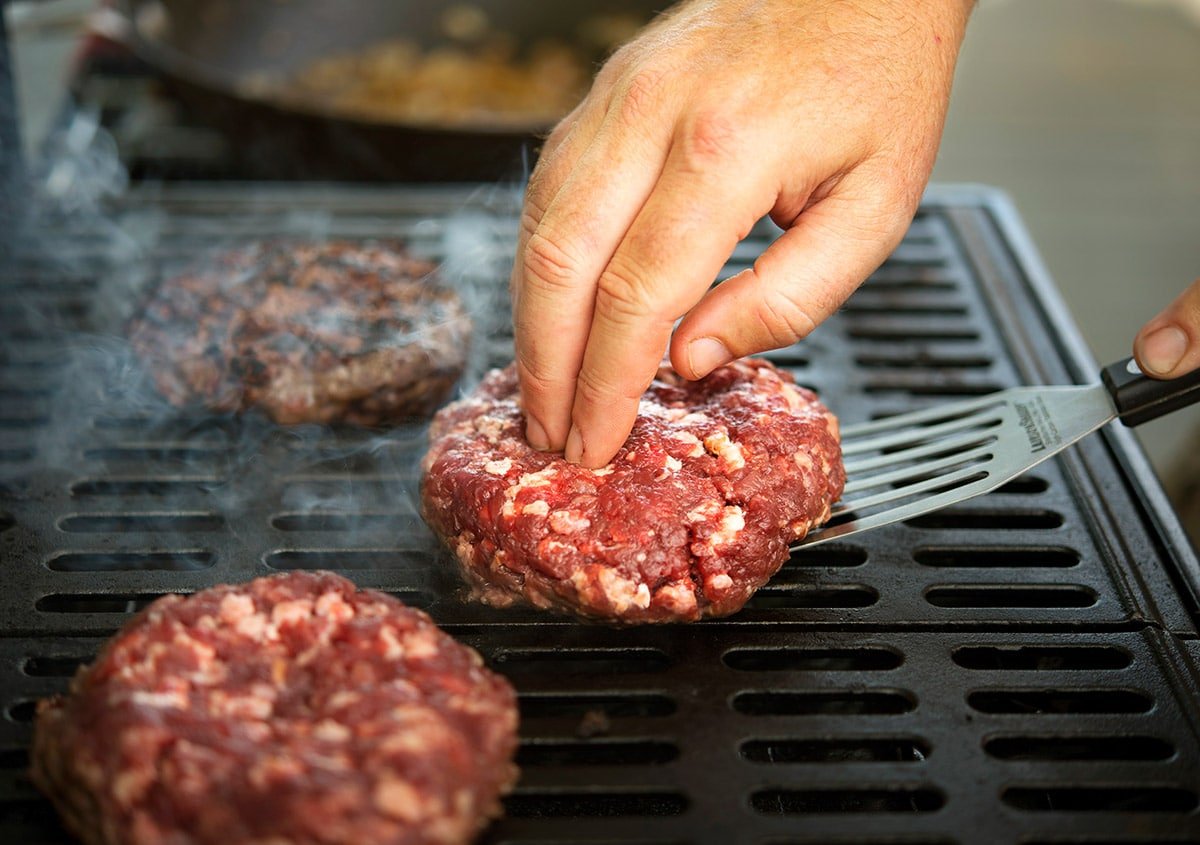
Coarse vs. Fine Grind
About those grinds. I use that clean, coarse grind for thick, big, grilled burgers. Coarsely ground meat is better for a grilled burger. My green chile elk burger is a great example of this. Finely ground meat is better for a skillet or griddle burger, like, say, an Oklahoma onion burger.
Obviously both work kinda-sorta in their opposite role, but I have to say that coarsely ground venison makes a shoddy diner-style smash burger.
Food Safety in Venison Burgers
I always cook my venison burgers medium to medium-well — so cooked, but still a little pink. About 145°F internal if you want specifics. It’s just how I like my burgers in general.
The biggest health risk you could in theory face with venison burgers is Chronic Wasting Disease — except that is has never ever been recorded in humans ever. (Here’s an article about the current state of the research on CWD.) If that ailment does jump the species barrier to humans, you’re hosed. No amount of cooking will kill it. So let’s just hope it doesn’t cross that species barrier.
Other than that, foodborne illness from venison is vanishingly rare. There are one or two cases of toxoplasmosis and e. coli 0157 bacteria poisoning every couple years, but considering the millions of pounds of venison eaten by millions of people, you’re more likely to get struck by lightning, surviving, then eaten by a shark.
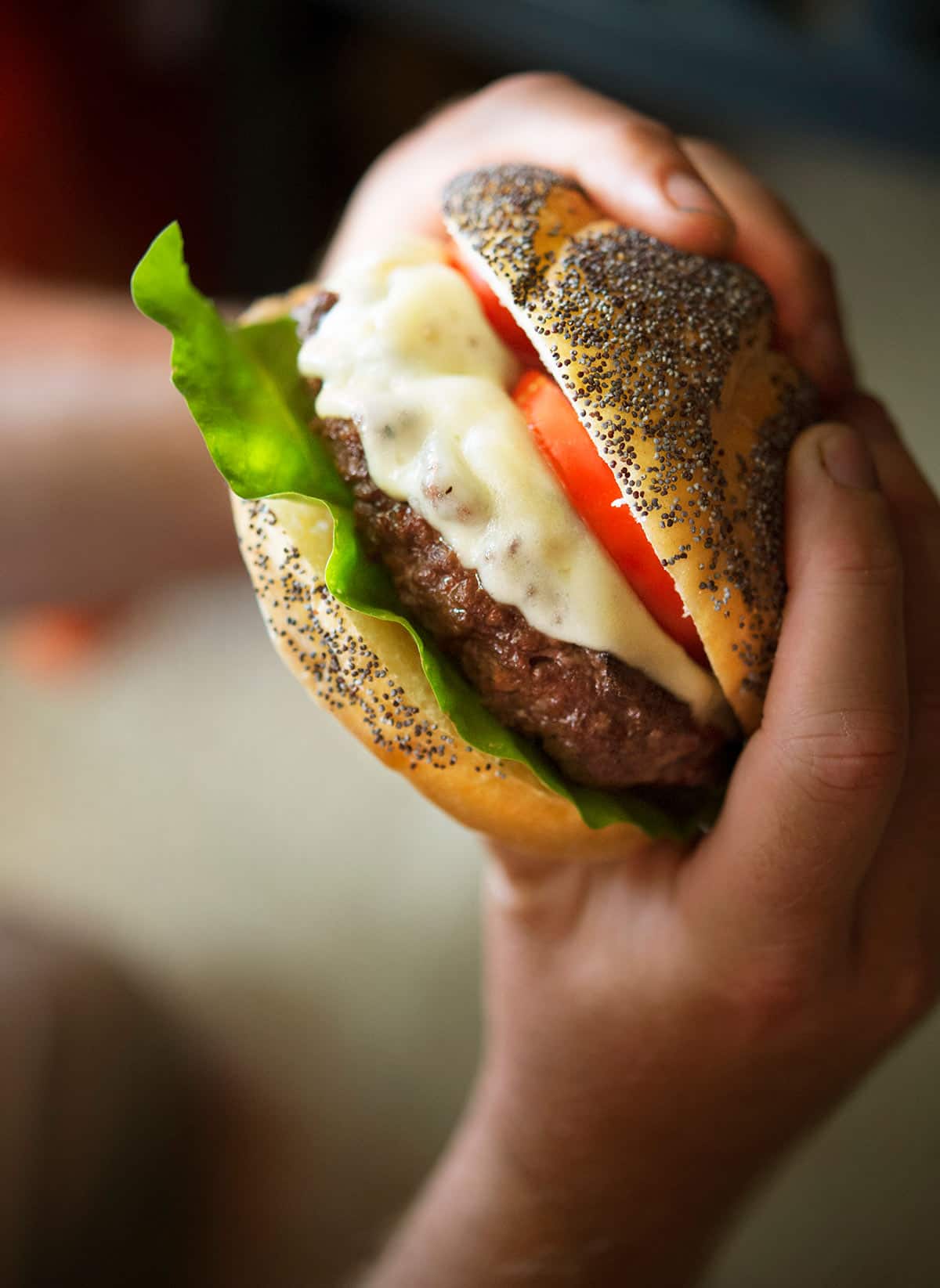
Toppings
This is one where I can’t really help you. This one is 100 percent up to you. I’ve had burgers with almost nothing on them, and I’ve had “burger stacks” so tall I could barely eat them, and everything in between.
Cheese or no cheese? Cooked or raw onions? Mayo? Mustard? Is it nobler to use hothouse tomatoes on your burger in winter or not to do so, and by opposing this outrageous arrow against seasonality, end the debate forever? (Sorry, Hamlet. Had to.)
Well, here is where I stand.
My Perfect Venison Burgers
I will preface all this by saying that this is, to me, a perfect burger. To you, it may not be. And you are free to disagree. That’s why this is America (or Canada, or wherever it is you happen to be reading this).
First: Start with a meat mixture that is about 15 percent fat by weight. This is standard with pre-ground venison you get from a processor, so no need to alter things if that’s how you are making venison burgers. Don’t go less than 10 percent.
Second: Grind your own if at all possible. This is the secret to virtually every great burger joint’s meat. Grinding your own takes less than 10 minutes (unless you are feeding an army), and gives you ultimate control over texture and composition. And in the world of venison burgers, this is what I’ve come to like best: Venison meat from the shoulder, ribs, neck or hind leg, ground with pork fat.
Side note: If you are grinding and then cooking right away, try using bacon ends. It’s amazing.
Third: Gently patties must you make, young padawan! So Sayeth Yoda. These aren’t meatballs, folks. Think of a burger like a you would a crabcake, which is supposed to just barely hold together. It’s a fine line between perfect and too crumbly, but a dense, packed patty is depressing and somehow un-American. This is the real hit on those venison burgers recipes that have lots of fillers — they are stiff and hard, not gentle and lovely like all the wondrous burgers you’ve eaten in your life.
Fourth: Salt only the outside of the burger, right before you cook or even when you flip the patty. This one matters. Salt denatures proteins, which is why sausage binds so well and, incidentally, has a very different texture from a good burger. Add salt to the meat mixture and you have a sausage patty, not a hamburger. And yes, people have done experiments proving this. (As for my bacon ends, which contain salt, I use them only when I grind and cook, not when I grind lots of burger in advance and freeze it.)
Fifth: Grilled burgers are only better when there’s wood or charcoal involved. Yes, I cook burgers over gas grills, and they are nice, but not qualitatively better than those done in a pan inside. Unless of course you add smoke chips to your gas grill. Meat + woodsmoke = awesome.
Sixth: Flip once, or several times. It doesn’t matter in the final judgment. And yes, people have done experiments proving this. I flip only once because I want a hard crust on the outside of the burger, which I find helps hold it together.
Seventh: Rest thine burgers. It’s the little-known 12th Commandment, lost in the making of Mel Brooks’ History of the World Part I. (The 11th Commandment has something to do with Republicans…) Why? Remember the original name of a hamburger: hamburger steak. You rest steaks right? Right? Please tell me you do…
Eighth: Let all else be free. Let your burger freak flag fly when it comes to toppings. Just let the meat be the star, OK?
Storing Venison Burgers
I tend to not store deer burger as patties. Mostly I will vacuum seal a couple pounds of fine, or coarse, burger grind and then make patties when I am going to cook them. Pro tip on vac sealing ground meat: Press the meat into the corners of the bag and flatten it out before sealing. Keeps air pockets from forming.
If you liked this recipe, please leave a ⭐️⭐️⭐️⭐️⭐️ rating and a comment below; I’d love to hear how everything went. If you’re on Instagram, share a picture and tag me at huntgathercook.
Venison Burgers
Ingredients
- 1 1/2 pounds venison
- 1/2 pound pork or beef fat, chopped roughly
- Salt (smoked salt if you have it)
- Freshly ground black pepper
- 3 tablespoons butter, lard or vegetable oil
- 1 large or 2 medium onions, thinly sliced
- Burger buns
- Something green like bibb lettuce, arugula, sorrel or spinach
- Slices of fresh tomato, or canned, fire-roasted peppers (winter), summer
- Slices of cheese of your choice
- Condiment of your choice (ketchup mustard, remoulade, mayo, etc)
Instructions
GRINDING YOUR OWN
- Make sure the meat and fat are cold. Cut the venison into chunks that will fit into your grinder. Do the same for the fat. Mix the two together roughly so you can add a bit of each into the grinder as you go. Grind through a medium (6 mm) plate for coarse burgers. If you want fine burgers, grind a second time through a 4.5 mm plate.
MAKING PATTIES
- Make between 4 and 6 patties, depending on how large you want your burgers. Form the patties with only as much force as absolutely needed -- you want the patties to hold together only loosely. Make them about 1/2 to 1 inch thick. Use your thumb to press an indentation into the center of each patty: This prevents the burgers from turning spherical when you cook them. Set the burgers aside.
- Heat the butter in a frying pan over medium-high heat. When it's hot, add the sliced onion and cook until it's done to your liking. Some people like juicy onion with a little char on the edges, some people prefer to go the full caramelized onion route. When finished, put the onions in a bowl so you can have them ready.
GRILLED BURGERS
- I prefer grilled burgers, so I'll go through that method. Heat your grill on high and be sure to scrape down the grates with a brush. Only salt your burgers right before you cook them. Place the patties on the grill and cook them without disturbing them (with the grill cover open) for 3 to 5 minutes, depending on how well done you like your burgers. Flip and cook for the same amount on the other side. I prefer 3 minutes per side with a really hot grill.
- When you flip the burgers, grind some black pepper over them, then spoon a little caramelized onion on each one if you'd like. With about 90 seconds to go on the second side, lay the cheese on top of the onions and cover the grill until the burger's ready. If you like toasted buns, toast them on the grill in this last 90 seconds. When everything's done, move the burgers and buns to a sheet tray or plate so the meat can rest for 5 minutes, while you build the burgers.
GRIDDLE BURGERS
- For griddled burgers inside on a frying pan, skillet or griddle, follow the instructions in my recipe for Oklahoma onion burgers. Basically you put the patty down, squash it, and then sear and flip. This method is faster than the grill method.
TOPPINGS
- You can do this any way you want, but I start with a green thing, then some ketchup or mayo or whatever, then the burger patty that has the onions and cheese already on it, topped with a slice of tomato (or roasted red pepper) and finally some more of whatever condiment I happen to be using. My method is just how I do things; you can do anything you'd like.
Video
Nutrition
Nutrition information is automatically calculated, so should only be used as an approximation.

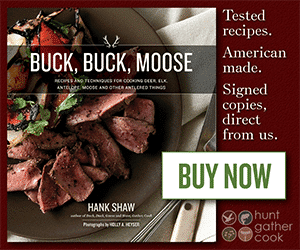
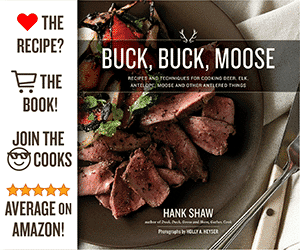

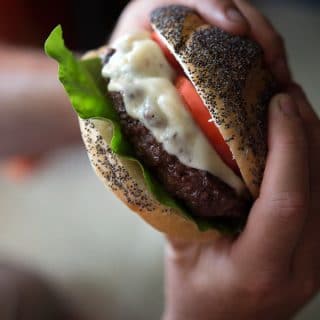

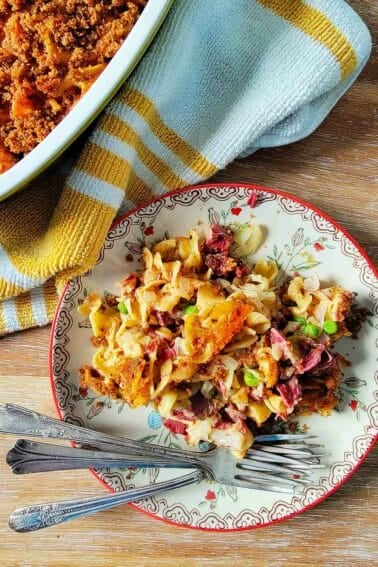
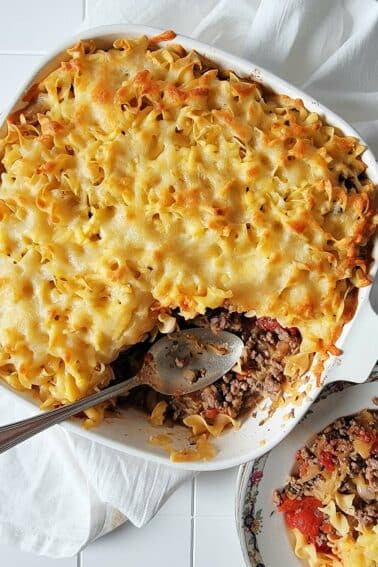
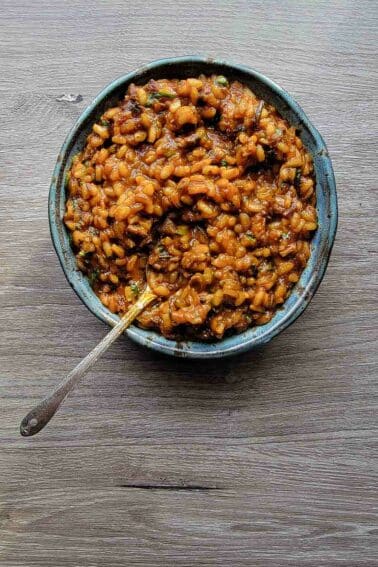
Hank, I ground all of our venison burger meat yesterday from the season, we collect it, freeze it and grind it all at the end of the season. Let it thaw just enough to cut through and make it through the grinder. 120 lbs yesterday. Took about 25 lbs and mixed pork fat at a 15% ratio from the neighbors hog we got this year. I used a coarse grind, but double ground it. Since we were in the garage and it’s cold here in michigan, the meat stayed mostly frozen through both grinds. I then made 1/4 lb patties with a patty press, wrapped and froze again. I tested a few and I’m very pleased with the result, I have to be a little gentle when cooking them, but they hold together well enough and taste great. I wish I would have read your post prior but I’m excited to have 25 ready made meals from the freezer for our family of 4…
This is awesome and I think I will try tomorrow. All our red meat we eat is game and I’m on a mission to master the burger…trying to find they key to flavor, texture and moisture!
I forgot to mention above that the ground chuck has 15% fat – thanks !
Hey – I think all the posts are great ! I just finished making sausage from a wild pig i killed sat. I also got a doe deer and tomorrow will work on it and make burger . I have experimented a lot over the years, and tomorrow i will add about 20% ground chuck and 10% smoked bacon. This is my best find to suit me ! The best thing to do is experiment in small batches and you’ll find what is best for your taste buds ! we are all different !!!
My processor always give me a hard time about not adding beef fat to my ground venison. The fat he uses is processed pelitized beef fat. It never melts or breaks down, when cooking chili for example, BB sized fat pellets float to the top. Here’s my recipe for a great venison burger or chopped steak
3 lbs no fat added ground venison
16 oz white button mushrooms
2 large yellow onions
1 stick salted butter
Salt and pepper
Directions : Melt butter, dice fine to small onions and sauté in butter till just past translucent, almost golden, the add diced fine to small mushrooms, cook until most of the moisture is cooked out, add salt and pepper to taste. Let cool the add mixture to venison. Don’t overwork, key to making any great burger, venison or otherwise. Make pattys any size you like. Put in freezer long enough for patties to hold the shape without falling apart. Cooking on grill or in a pan use high heat to form a crust on both sides, then lower temp,move to oven or cook to desired temp using indirect method on grill with lid down. Remember never mash the burgers and let rest !
Jonathan: I personally don’t like no-fat burgers at all. But thanks for offering an example for those people who do.
The beef trim worked great. I guess the only reason you might want to use unrendered fat over trim is that it is cheaper.
I’ve been experimenting with a Louisiana blackened venison burger. The meat has no added fat, the butter does the job. Good stuff!
Hi Hank,
I butchered this year’s deer myself with friends and ended up with a bunch of burger, which we ground that day and then froze. We left some deer fat in the mix. After reading your recipes the 80/20 pork fat mixture sounds great for burgers as well as meatloaf. Would I now grind some bacon or other pork fat and then mix it by hand into the already ground venison? (The deer fat that’s in there is minimal.)
Thanks!
Cabot: Yep, I’d do that. Make sure the fat is ground at least as fine if not a little finer than the meat.
Hi Hank,
Last year I used a recipe of yours for venison burgers. As far as I remember it was just spices and meat. The best burger I have tasted! Unfortunately i never wrote it down and I can’t find it on your site. This is all I could find on it –
“Venison burgers are a staple in many a game cook’s repertoire, but I actually rarely make burgers. But when I do, I tend to sex them up with herbs and spices. This recipe is sorta vaguely Hungarian style, but it tastes really, really good. Most venison is too lean to make into a burger by […]”
Could you please, please send me the recipe, I promise I’ll write it down this time.
Thank you!
I have just came across a bit of deer meat. I’m going with the 80/20 deer to fatty-bacon ratio. The deer has so little fat, I think bacon fat is the best way to go.
Someone mentioned cheese: If you like burnt cheese I guess. Someone mentioned egg, but egg makes the entire burger processed-like, and gluey. Cow fat works, but pig fat works better (especially in a small kitchenaid food grinder.) But the type of fat should really be deer fat! (I don’t know how many deer you’d have to butcher to get enough fat for a 80/20 ratio o.O)
Hank Shaw, sorry but could you confirm if the pounds are American pounds? Or please post the quantities (i.e. pounds) in metric or UK pounds? Just want to be sure I’m having the right quantities in the recipe. Thanks!
Inka: As I am an American, everything’s in U.S. pounds. 😉
I do not add fat to my burgers i add 1egg to about two pounds of meat to hold together a little worcheshire saucethere curry powder and if my son is there fry or grill lightly toasted buns and toppings to taste
Cheese has no business on a hamburger…
LOL. Uh… to each his own.
Venison burger? When you add 20% beef or pork fat they are then mixed meat burgers. I grind only venison and add shredded cheese to the meat before I shape it into burgers. This adds the fat needed to hold it all together and forms a crust on the meat to keep the moisture in. Why put the cheese on the burger when you can have it in the burger? Try it, you’ll like it.
Hi Will and Hank,
there is indeed a fascinating wealth of information genuineideas.com But I don’t think I end up with the same conclusion as you will concerning the salting of your burger. It says that salting the interior prevents more weight loss (so more juiciness) as it binds to a greater surface of the meat. Look at this one : https://www.genuineideas.com/ArticlesIndex/saltyburger.html
You simply need to be careful not to oversalt it, so it doesn’t become sticky like a sausage, as Hank outlined. But a small quantity of salt won’t denature proteins and will prevent juices from oozing out. Bottom line: a little salt before making the patties to increase juiciness and little salt on the patties so it doesn’t crumble in your grill?
Alright, just this one more then I’ll stop posting random links on your burger recipe page.
This came from the same site as the above link and confirms exactly what you were saying regarding salting the burger. Partway down the article there is a pictorial of ground beef with cross-cuts showing the textural effects of salting the meat on the inside and then cooking vs. just salting the outside.
It’s also a fairly fascinating breakdown of different methods of salting, wet and dry brining and the effects on different cuts of meat.
https://www.genuineideas.com/ArticlesIndex/brine.html
Thought you might find this interesting on resting meat. I keep trying both resting and not and I feel each has its merits. But it’s not as settled an issue as some would like you to believe. Some of the best steakhouses in the country don’t subscribe to it.
Anyway makes for some interesting reading-
https://www.genuineideas.com/ArticlesIndex/rest.html
Regardless, I’m having venison burgers tomorrow and I might just rest them this time…..
Then again, maybe I’ll just want to dig in…..
Thanks! I will look at that piece. Always looking to learn something new.
I never knew about salt trick…now I must test.
I’m pretty much in tune with a whole lot of what you do cooking/grilling Hank, but I gotta disagree on venison burger meat. I grill up my homemade bacon & put it on the burger later if I want a bacon burger. Using beef fat, your burger meat can be used for much more than just burgers. Don’t use beef suet (kidney fat). It’s what is too “waxy” (tallow has already been processed like lard). Use beef “trim”, the extra fat they trim off of rib eyes & porterhouse steaks etc. The butcher with the highest quality meats will have the highest quality trim. Get that & mix at least 10% with LEAN venison. Need 10% or the burger won’t hold together. May need more if you insist on cooking past medium rare or they can get a little dry. Medium rare tastes best & I know it’s safe because I know that none of my burger meat came from the cutting room floor or sat in a grocery store cooler for two or three weeks before hitting the grill.
You are definitely right, and I’ve used fatty beef trim before. But I still prefer pork fat. But that’s just me. Nothing intrinsically wrong with using beef fat, though.
I am reminded of a bit from Lee Iacocca’s autobiography about Henry Ford II’s favourite hamburgers.
https://professornerdster.com/two-ways-make-money/